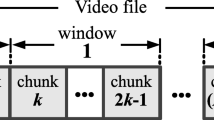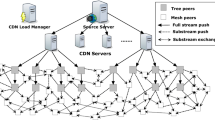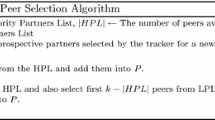Abstract
Overlay networks and peer-to-peer networking have emerged as alternative solutions to solve many problems related to massive information distribution and processing tasks by providing enhanced services in the application layer. For instance, overlay networks can improve data dissemination in P2P file sharing overlays and Content Distribution Networks (CDNs). In such overlay networks, delay is considered as a critical performance metric. A viable content distribution model could considerably minimize the completion time and would lead to efficient utilization of resources such as network bandwidth. The main objective of this paper is to design a new flexible content distribution model for fast data dissemination in overlay networks with heterogeneous nodes. The proposed “Semi-Fluid” content distribution model is a hybrid model that enables fast data dissemination in overlay networks by combining Chunk and Fluid content distribution models. In this new content distribution model, the chunk content is distributed into heterogeneous overlay nodes in a fluid manner. The proposed hybrid content distribution model eliminates both a backpressure problem caused by the Fluid content distribution model, as well as a chunk transition delay caused by the Chunk content distribution model. The performance of the proposed Semi-Fluid content distribution model has been evaluated by mathematical analysis as well as by real implementation over the “PlanetLab” platform, and the obtained results show that the Semi-Fluid content distribution model efficiently reduces the total download time of the clients. Hence, the Semi-Fluid content distribution model can be deployed as a promising solution for fast data dissemination in heterogeneous overlay networks.













Similar content being viewed by others
References
Shen X, Yu H, Buford J, Akon M (2009) Handbook of peer-to-peer networking. Springer, New York
Tarkoma S (2010) Overlay networks: Toward information networking. Auerbach Publications, New York
Galán-Jiménez J, Gazo-Cervero A (2011) Overview and challenges of overlay networks: A survey. Int J Comput Sci Eng Surv (IJCSES) 2:19–37. doi:10.5121/ijcses.2011.210219
Mundinger J, Weber R, Weiss G (2006) Analysis of peer-to-peer file dissemination. ACM SIGMETRICS Perform Eval Rev 34:12–14. doi:10.1145/1215956.1215963
Liu Y, Guo Y, Liang C (2008) A survey on peer-to-peer video streaming systems. Peer-to-Peer Netw Appl 1:18–28, ISSN: 1936–6442
Wang J, Wang C, Yang J, An C (2011) A study on key strategies in P2P file sharing systems and ISPs’ P2P traffic management. Peer-to-Peer Netw Appl 4:410–419. doi:10.1007/s12083-010-0098-7
Saleh SN, Feily M, Ramadass S, Hannan A (2011) Performance study of fluid content distribution model for Peer-to-Peer overlay networks. In: Advances in wireless, mobile networks and applications. Springer, Berlin Heidelberg, 154, pp181-190. doi:10.1007/978-3-642-21153-9_17
Feily M, Saleh SN, Ramadass S (2012) A hybrid content distribution model for fast data dissemination in overlay networks. In: Proc IEEE CCNC 2012 Research Student Workshop, Las Vegas, Nevada USA, pp 722–724. doi:10.1109/CCNC.2012.6181150
PlanetLab: http://www.planet-lab.org.
Kumar R, Ross KW (2006) Optimal peer-assisted file distribution: Single and multi-class problems. In: Proc IEEE (HOTWEB’06). doi:10.1.1.63.5807
Kumar R, Ross KW (2006) Peer assisted file distribution: The minimum distribution time. In: Proc IEEE (HOTWEB’06). doi:10.1.1.82.426
Chan JSK, Li VOK, Lui SK (2007) Performance comparison of scheduling algorithms for peer-to-peer collaborative file distribution. IEEE J Sel Areas Commun 25:146–154, ISSN: 0733–8716
Lingjun M, Xiaolei M, Lui KS (2008) A novel peer grouping scheme for P2P file distribution networks. In: Proc IEEE (ICC’08), pp 5598–5602. doi:10.1109/ICC.2008.1049
Lingjun M, Lui KS (2008) Scheduling in P2P file distribution-on reducing the average distribution time. In: Proc IEEE (CCNC 2008), pp 521–522. doi:10.1109/ccnc08.2007.121
Tellium D. P, Pendarakis D, Verma D (2001) ALMI: An application level multicast infrastructure. doi:10.1.1.25.4223
Urvoy-Keller G, Biersack E (2002) A congestion control model for multicast overlay networks and its performance. doi:10.1.1.19.8008&rep=rep1&type=pdf
Templemore-Finlayson J, Budkowski S (2003) REALM: A reliable application layer multicast protocol. doi:10.1.1.86.7643
Chaintreau A, Baccelli F, Diot C (2001) Impact of network delay variations on multicast sessions with TCP-like congestion control. In: Proc IEEE (INFOCOM 2001), pp1133–1142. doi:10.1109/INFCOM.2001.916307
Kostić D, Rodriguez A, Albrecht J, Vahdat A (2003) Bullet: High bandwidth data dissemination using an overlay mesh. In: Proc ACM (SOSP 2003), pp 282–297. doi:10.1145/945445.945473
Kwon GI, Byers JW (2004) ROMA: Reliable overlay multicast with loosely coupled TCP connections. In: Proc IEEE (INFOCOM 2004), pp 385–395. IEEE Press (2004). doi:10.1109/INFCOM.2004.1354511
Zhu Y, Li B, Guo J (2004) Multicast with network coding in application-layer overlay networks. IEEE J Sel Areas Commun 22:107–120. doi:10.1109/JSAC.2003.818801
Chan JSK, Li VOK, Lui SK (2005) Scheduling algorithms for peer-to-peer collaborative file distribution. doi:10.1109/COLCOM.2005.1651215
Ren D, Li YTH, Chan SHG (2008) On reducing mesh delay for peer-to-peer live streaming. In: Proc IEEE (INFOCOM 2008), pp 1058–1066. doi:10.1109/INFOCOM.2008.160
Mundinger J, Weber R, Weiss G (2008) Optimal scheduling of peer-to-peer file dissemination. Springer J Sched 11:105–120. doi:10.1007/s10951-007-0017-9
Guo Y, Liang C, Liu Y (2008) AQCS: Adaptive queue-based chunk scheduling for P2P live streaming. doi:10.1007/978-3-540-79549-0_38
Rodriguez P, Biersack EW (2002) Dynamic parallel access to replicated content in the Internet. IEEE/ACM Trans Netw 10:455–465
Meng Z, Jian-Guang L, Li Z, Shi-Qiang Y (2005) A peer-to-peer network for live media streaming using a push-pull approach. doi:10.1145/1101149.1101206
Sanghavi S, Hajek B, Massoulie L (2007) Gossiping with multiple messages. IEEE Trans Inf Theory 53:4640–4654
Ma L, King-Shan L (2008) Scheduling in P2P file distribution - on reducing the average distribution time. In: Proc IEEE CCNC 2008, pp 521–522. ISSN: 0197–2618
BitTorrent (2010) peer-to-peer file sharing protocol. http://www.bittorrent.com/
Erdil DC (2011) Simulating peer-to-peer cloud resource scheduling. Peer-to-Peer Netw Appl 1–12. ISSN: 1936–6442
Ahlswede R, Cai N, Li SYR, Yeung RW (2000) Network information flow. IEEE Trans Inf Theory 46:1204–1216. doi:10.1109/18.850663
Wang M, Li B (2006) How practical is network coding? In: Proc IEEE (IWQoS 2006), pp 274–278. doi: citeseerx10.1.1.77.6402
Saleh SN (2010) Semi-fluid: A content distribution model for faster dissemination of data. Ph.D. Thesis, UNIVERSITI SAINS MALAYSIA (USM), pp 58–103
Chou PA, Wu Y, Jain K (2004) Network coding for the internet. Microsoft Research website: http://research.microsoft.com/pubs/78173/ChouWJ04.pdf
Acknowledgment
The authors graciously acknowledge the grand support from the UNIVERSITI SAINS MALAYSIA (USM) through the Postgraduate Research Grant Scheme (PRGS) and the USM Fellowship awarded to Miss Maryam Feily. We would like to convey our sincere appreciation to “Dr. Andrew Meulenberg” for his awesome support and remarkable assistance provided to us for writing and polishing the current paper. Besides, the authors gratefully acknowledge the invaluable assistance of anonymous reviewers in improving the quality of the paper by providing valuable comments on the earlier version of the paper.
Author information
Authors and Affiliations
Corresponding author
Additional information
Maryam Feily is an IEEE Graduate Student Member
Rights and permissions
About this article
Cite this article
Saleh, S.N., Feily, M., Ramadass, S. et al. Semi-Fluid content distribution model for fast data dissemination in heterogeneous overlay networks. Peer-to-Peer Netw. Appl. 7, 159–174 (2014). https://doi.org/10.1007/s12083-012-0192-0
Received:
Accepted:
Published:
Issue Date:
DOI: https://doi.org/10.1007/s12083-012-0192-0




